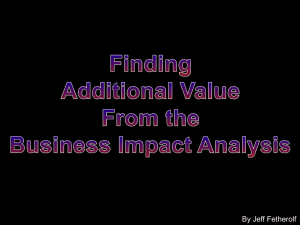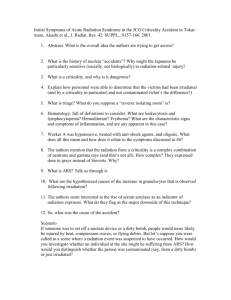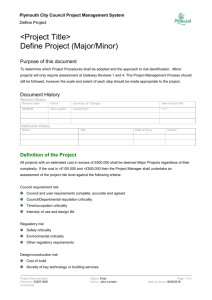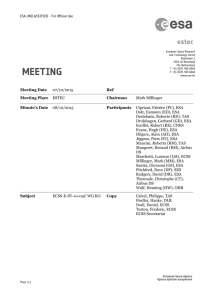Software criticality classification and reduction
advertisement
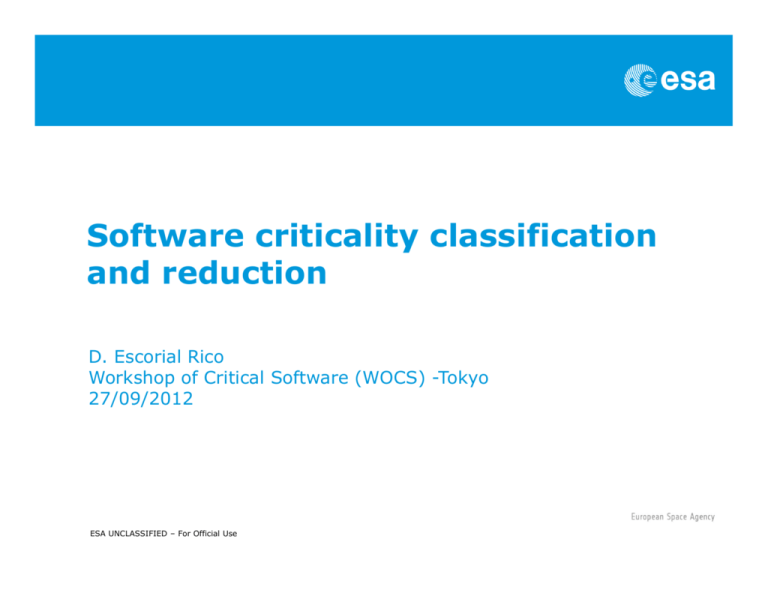
Software criticality classification and reduction D. Escorial Rico Workshop of Critical Software (WOCS) -Tokyo 27/09/2012 ESA UNCLASSIFIED – For Official Use Context Software more and more used in the space domain in important functions Classification of software components Implications of criticality classification of Software Software safety and dependability discipline: software related failures D. Escorial Rico | Workshop of Critical Software (WOCS) -Tokyo | 27/09/2012 | D/TEC | Slide 2 ESA UNCLASSIFIED – For Official Use More context – ESA and ECSS Terms and Requirements from ECSS – European Cooperation for Space Standardisation Evolution of applicable standards for ESA projects – European Space Agency Study for software criticality classification and reduction D. Escorial Rico | Workshop of Critical Software (WOCS) -Tokyo | 27/09/2012 | D/TEC | Slide 3 ESA UNCLASSIFIED – For Official Use Software Criticality Analysis – Process System level dependability and safety analysis Software products specifications Hardware-Software interaction analysis Software Criticality Analysis Classification of software components Measures for handling of Critical software Design recommendations for criticality reduction D. Escorial Rico | Workshop of Critical Software (WOCS) -Tokyo | 27/09/2012 | D/TEC | Slide 4 ESA UNCLASSIFIED – For Official Use Software Criticality Analysis – Process cont’d Software components functional analysis Software dependability analysis Criticality reduction D. Escorial Rico | Workshop of Critical Software (WOCS) -Tokyo | 27/09/2012 | D/TEC | Slide 5 ESA UNCLASSIFIED – For Official Use Software Criticality Analysis – Functional analysis Software products specifications Hardware-Software Interaction analysis Software components functional analysis Software components Functions implemented by software components Software components interactions D. Escorial Rico | Workshop of Critical Software (WOCS) -Tokyo | 27/09/2012 | D/TEC | Slide 6 ESA UNCLASSIFIED – For Official Use Software Criticality Analysis – Software dependability analysis Software components Functions implemented by software components Software components interactions Software dependability analysis: Software Failure Modes, Effects and Criticality Analysis Software Fault-Tree Analysis Failure mitigation measures Design recommendations Classification of software components Measures for handling critical software D. Escorial Rico | Workshop of Critical Software (WOCS) -Tokyo | 27/09/2012 | D/TEC | Slide 7 ESA UNCLASSIFIED – For Official Use Software Criticality Analysis – Criticality reduction Failure mitigation measures Design Recommendations Classification of software components Criticality Reduction Design recommendations for criticality reduction D. Escorial Rico | Workshop of Critical Software (WOCS) -Tokyo | 27/09/2012 | D/TEC | Slide 8 ESA UNCLASSIFIED – For Official Use How Software is classified Main ECSS criteria to classify software: Depends on the consequences of a software caused failure Software malfunction: Software not executed when expected, or not correctly executed, or with anomalous behaviour or contributing to a system failure D. Escorial Rico | Workshop of Critical Software (WOCS) -Tokyo | 27/09/2012 | D/TEC | Slide 9 ESA UNCLASSIFIED – For Official Use ECSS-Q-ST-80C – Software criticality categories Category Definition A Software that if not executed, or if not correctly executed, or whose anomalous behaviour could cause or contribute to a system failure resulting in: Catastrophic consequences B Software that if not executed, or if not correctly executed, or whose anomalous behaviour could cause or contribute to a system failure resulting in: Critical consequences C Software that if not executed, or if not correctly executed, or whose anomalous behaviour could cause or contribute to a system failure resulting in: Major consequences D Software that if not executed, or if not correctly executed, or whose anomalous behaviour could cause or contribute to a system failure resulting in: Minor or Negligible consequences D. Escorial Rico | Workshop of Critical Software (WOCS) -Tokyo | 27/09/2012 | D/TEC | Slide 10 ESA UNCLASSIFIED – For Official Use ECSS-Q-ST-30C and Q-ST-40C – Dependability and Safety Severity Dependability Consequences Safety consequences Catastrophic Failures propagation Loss of life Severe detrimental environmental effects Critical Loss of mission Temporarily disabling but not life‐ threatening injury Major detrimental environmental effects Major Major mission degradation Minor or Negligible Minor mission degradation or any other effect D. Escorial Rico | Workshop of Critical Software (WOCS) -Tokyo | 27/09/2012 | D/TEC | Slide 11 ESA UNCLASSIFIED – For Official Use Measures for handling critical software Depending on the Software Criticality: Project applies more or less strict engineering and Product Assurance requirements – Tailoring Critical software presents a risk for the mission, mitigated by more severe and costly requirements during whole software life cycle D. Escorial Rico | Workshop of Critical Software (WOCS) -Tokyo | 27/09/2012 | D/TEC | Slide 12 ESA UNCLASSIFIED – For Official Use Different requirements for different categories of software – Examples Test coverage targets Code coverage versus criticality category A B C D Source code statement coverage 100% 100% AM AM Source code decision coverage 100% 100% AM AM Source code modified condition and decision coverage 100% AM AM AM AM: Agree & Measure Independent Software Verification and Validation performed by a third party Process Assessments and Improvement D. Escorial Rico | Workshop of Critical Software (WOCS) -Tokyo | 27/09/2012 | D/TEC | Slide 13 ESA UNCLASSIFIED – For Official Use Software Criticality Classification – Approach The criticality of SW is assigned considering the overall system design: Compensating provisions that can prevent or mitigate failure consequences (e.g. inhibits, monitors, operational procedures) One or more independent back-ups exist for the function implemented by the SW *Please note that the approach for SW criticality reduction presented is not part of the ECSS standards D. Escorial Rico | Workshop of Critical Software (WOCS) -Tokyo | 27/09/2012 | D/TEC | Slide 14 ESA UNCLASSIFIED – For Official Use SW Criticality category Reduction – Conditions for compensating provisions Conditions are established for acceptable compensating provisions in the SW criticality assignment, i.e. • Effectiveness of compensating provisions must be demonstrated in all situations • No common cause of failure between software and compensating provisions • Sufficient time to intervene in all situations • Probabilistic assessment cannot be used as a criterion for SW criticality reduction D. Escorial Rico | Workshop of Critical Software (WOCS) -Tokyo | 27/09/2012 | D/TEC | Slide 15 ESA UNCLASSIFIED – For Official Use SW Criticality category Reduction – Conditions – cont’d • The SW criticality category must be assigned based on the severity of the residual failure modes, i.e. the ones remaining after the compensating provisions become effective (including loss of function) • If monitors or inhibits are used as compensating provisions, any SW contained in them must be classified at the criticality corresponding to the most severe failure they compensate D. Escorial Rico | Workshop of Critical Software (WOCS) -Tokyo | 27/09/2012 | D/TEC | Slide 16 ESA UNCLASSIFIED – For Official Use Verification of reduction provisions Verification of effectiveness and timeliness of compensating provisions (implemented in software, hardware, operations or a combination thereof) against potential software errors D. Escorial Rico | Workshop of Critical Software (WOCS) -Tokyo | 27/09/2012 | D/TEC | Slide 17 ESA UNCLASSIFIED – For Official Use SW Criticality category reduction – Issues Possibility that low critical software causes the failure of high critical software: • Prevention of failure propagation • Identification of shared resources D. Escorial Rico | Workshop of Critical Software (WOCS) -Tokyo | 27/09/2012 | D/TEC | Slide 18 ESA UNCLASSIFIED – For Official Use Prevention of Failure Propagation– Research Study Research study on going Propagation from Lower Criticality to Higher Criticality: • Interactions of SW components • Types of failures that might propagate • Prevention mechanisms D. Escorial Rico | Workshop of Critical Software (WOCS) -Tokyo | 27/09/2012 | D/TEC | Slide 19 ESA UNCLASSIFIED – For Official Use Prevention of Failure Propagation – Some examples Interaction Failure type in low criticality Impact in higher criticality Prevention Mechanism Synchronous Aborted Abortion of calling thread Watchdog on return from call Asynchronous Timing failure Tolerated or causes deadline miss or timeout Timeouts on return Resource sharing Arbitrary (including system crash) Firewalling Resource violation D. Escorial Rico | Workshop of Critical Software (WOCS) -Tokyo | 27/09/2012 | D/TEC | Slide 20 ESA UNCLASSIFIED – For Official Use Prevention of Failure Propagation – Supervisors Supervisor To monitor the behaviour of the system Checking a given set of properties (values, time constraints, …) The supervised computer performs safe (harmless), not necessarily correct actions D. Escorial Rico | Workshop of Critical Software (WOCS) -Tokyo | 27/09/2012 | D/TEC | Slide 21 ESA UNCLASSIFIED – For Official Use Prevention of Failure Propagation – Firewalls/Partitioning Firewall To protect different parts of a software system by isolating them from each other Partitioning To isolate different software components Memory partitioning Processor time partitioning D. Escorial Rico | Workshop of Critical Software (WOCS) -Tokyo | 27/09/2012 | D/TEC | Slide 22 ESA UNCLASSIFIED – For Official Use Conclusions Improvement of the Software Criticality Analysis process Criticality reduction measures framework Strict conditions to reduce criticality Study on prevention of failure propagation * Please note that the approach for SW criticality reduction presented is not part of the ECSS standards D. Escorial Rico | Workshop of Critical Software (WOCS) -Tokyo | 27/09/2012 | D/TEC | Slide 23 ESA UNCLASSIFIED – For Official Use ECSS references ECSS‐Q‐ST‐80C – Space product assurance – Software product assurance ECSS‐Q‐HB‐80‐03A – Space product assurance – Software dependability and safety ECSS-E-ST-40C – Space engineering – Software Engineering ECSS‐Q‐ST‐30C – Space product assurance ‐ Dependability ECSS‐Q‐ST‐40C – Space product assurance – Safety ECSS‐Q‐ST‐30‐02C – Space product assurance – Failure modes, effects and criticality analysis (FMECA/FMEA) ECSS‐Q‐ST‐30‐09C – Space product assurance – Availability analysis ECSS‐Q‐ST‐40‐21C – Space product assurance – Fault tree analysis – Adoption notice ECSS/IEC 61025 D. Escorial Rico | Workshop of Critical Software (WOCS) -Tokyo | 27/09/2012 | D/TEC | Slide 24 ESA UNCLASSIFIED – For Official Use ESA Software Product Assurance Workshop – June 2013 Dates and Venue: 12-13 June 2013 at ESA/ESTEC, The Netherlands "Intensifying dialogue on Software Product Assurance matters and obtain feedback from Industry" Topics: • Software Dependability and Safety • Software Product Service History and Reuse • Software Product Evaluation for Conformity • Software Engineering for evolving technologies • Research and Development activities in the field of SW Product Assurance D. Escorial Rico | Workshop of Critical Software (WOCS) -Tokyo | 27/09/2012 | D/TEC | Slide 25 ESA UNCLASSIFIED – For Official Use
